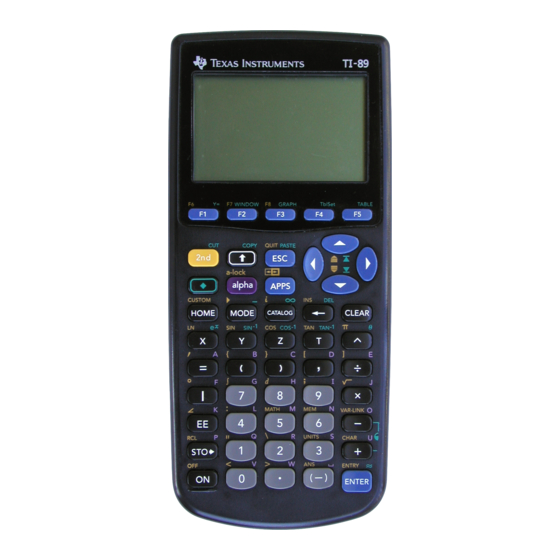
Texas Instruments TI-89 Tip List
Graphing calculator
Hide thumbs
Also See for TI-89:
- Developer's manual (1398 pages) ,
- User manual (1009 pages) ,
- Manual book (623 pages)
Table of Contents
Advertisement
Quick Links
Neither I, Doug Burkett, nor any of the contributors to this tip list are responsible in any way
for any damage of any kind that you or anyone else may incur from using the information in
this tip list. These tips are provided for educational purposes only. The contributors and I
believe that all information is accurate and reliable, but we make no expressed or implied
warrantee or guarantee to that effect. Some tips may involve hardware or software
modifications to the calculator that may void the manufacturer's warrantee.
This document is a collection of useful tips and hints relating to the TI-89 and TI-92 Plus calculators.
The tips come from user experience and many other sources, and apply to all facets of calculator
operation and programming. The tip list has grown to include reference material, humor and oddities,
so perhaps the name Tip List, is no longer appropriate, but it stands for now.
The tip list is not a buglist, a wishlist or a FAQ. I maintain a wishlist, and good FAQs are available.
While a FAQ is, by definition, frequently asked questions, this list instead describes useful techniques
which may be 'infrequently asked'. These are sophisticated calculators and some features are not
obvious. All users have different skills, and what is obvious to some is not obvious to all.
I want the tip list to be the ultimate, exhaustive source of TI-89 / TI-92+ operation. If you find a good tip
or clever solution, please email me. In general I give credit to the first person to submit a particular tip.
Let me know if your tip is from a manual, or you really learned it from someone else. If a tip gives no
credit, that only means I came up with it on my own, not that I am the original inventor.
Bhuvanesh Bhatt has generously volunteered to keep this list on his site:
http://triton.towson.edu/~bbhatt1/ti/
Thanks Bhuvanesh! Bhuvanesh also maintains a bug list for these calculators.
Through the gracious efforts of Andrew Cacovean, the tip list is also available here:
http://www.angelfire.com/realm/ti_tiplist/
Andrew developed and maintains this site. You can download the entire tip list or individual tips, tip list
code and also the wishlist. Andrew has also written some very good examples of operation.
TI-89 / TI-92 Plus Tip List 10.0
Compiled by Doug Burkett, dburkett@infinet.com
Created 12 aug 99, revised 20 July 2002
Copyright 1999-2002 Doug Burkett. All rights reserved.
Dedicated to my wife,
Janet Katherine Scholz Burkett,
who cheerfully tolerates all this silliness...
Important!
0 - 1
Advertisement
Table of Contents

















Need help?
Do you have a question about the TI-89 and is the answer not in the manual?
Questions and answers